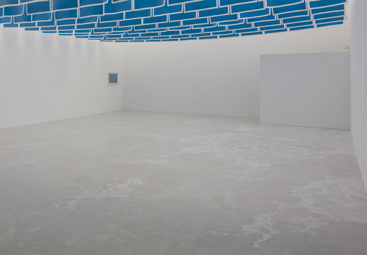
Born in Pensacola (US). Lives and works à Paris (FR)

2013
Painting, work to achieve from a procedure.
Dimensions variables, surface minimum 65m2.
Year of Purchase: 2013
Prior to the artistic gesture, which includes her devices, minimal object sculptures, and subtle mural paintings there is, in Dominique Ghesquière’s work, the simple, shared experience of the world, its natural elements, and everyday objects. The artist approaches this experience with the patience of surface touch, sustained by precise, slow observation. It’s the kind of observation that exposes the reality through an act of contemplation reaching out into the singularity and layered with the question of “how”; observation that grasps the illusory appearance of everything in order to tear it apart, to unravel it until it touches the essence of things and forms, materials and surfaces. “… I simply try to blend with the landscape. I am looking for precision and necessity…. As much as possible, I always use generic objects. … This allows me to obtain a certain degree of abstraction.” 1 Dominique Ghesquière’s artworks thus share the radical simplicity of their titles, reduced to the name of the thing or object: carpet (2001); scaffolding (2003); permanent rain (2003); bucket (2008); stepladder (2008); foam (2013)… But does this naming coincide with the thing, “faithfully conforming with what things themselves show us”?2 The artist outwits this conformity, subverts the objects’ functions through her use of inadequate, fragile, worn materials and through the absence of the habitual material. These objects are sculpted doubts. It is by means of a three-dimensional image, which distorts the expectations of reality, stretched between mimetic likeness and its displacement, that the artist foregrounds the very essence of things. “Who experiences things deeply and feels an intimate union with those things, necessarily expresses himself obscurely. For clarity ends a few inches from the surface,” says Paul Valéry3: Dominique Ghesquière resides in this poetic “knowledge.”
Foam is a mural painting to be executed according to a set of instructions on the floor of the exhibition hall using sinuous, random, and capricious traces, a spider web of shimmering, mineral, or misty whiteness: a weave of opacity. A moment of a marine landscape sketched in its essence and in its fixed temporality. “What is foam?”—should one this question even before one is able to see clearly? Air bubbles forming in the imperceptible instant, at the brief moment when the wave comes to a halt before it ebbs. With the help of visual material and the delicate act of covering the floor, Dominique Ghesquière brings two surfaces into contact, showing the fleetingness, the fragility, the movement—passing and repeated, returning back to the visible the form of a phenomenon and the becalmed instant of its presence in the landscape. Foam is stories and geographies of uncertainties and drifting moments; it “is,” in its ephemeral materiality and memory, the image, corporeal and poetic, before which we experience the known and the unknown, the everlasting brevity of time.
Marjorie Micucci
1 “Conversation avec Dominique Ghesquière et Frédéric Oyharçabal” in Dominique Ghesquière, monographic catalog (Dijon: FRAC Bourgogne / Presses du reel, 2011)
2 Martin Heidegger, What is a Thing? Trans. W.B. Barton and Vera Deutsch (South Bend, IN: Gateway Editions, 1967).
3 Paul Valéry, Mauvaises Pensées et autres (Paris: Gallimard, 1942).